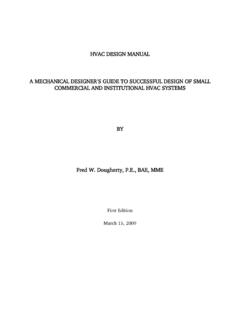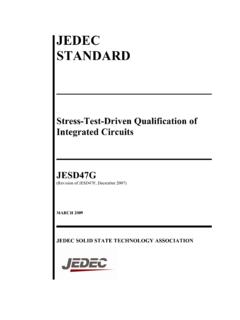Transcription of Passivhaus primer: Designer’s guide A guide for the design ...
1 Passivhaus primer: designer s guideA guide for the design team and local authoritiesBRE is registered with the Passivhaus Institut as an official Certifier for Passivhaus Primer designer s guideSurface area increaseof 20%Increase in insulation = 40mmPassivhaus Primer designer s guide : A guide for the design team and local authoritiesOrientationWhere possible a Passivhaus building should be orientated along an east/west principle axis so that the building faces within 30 degrees of due south (in the Northern hemisphere). This allows the building to derive maximum benefit from useful solar gains, which are predominantly available to south facing facades during the winter months. With good planning a Passivhaus building can also be realised where a south facing orientation is not possible, although the annual heating demand may increase by 30-40% as a formThe compactness of a building is indicated by the surface area to volume (A/V) ratio.
2 This ratio, between the external surface area and the internal volume of a building, has a considerable influence on the overall energy demand. Buildings with identical U-values and air change rates, and orientations could have significantly different heating demands simply as a result of their A/V size of a building also influences the A/V ratio. Small buildings with an identical form have higher A/V ratios than their larger counterparts. It is therefore particularly important to design small detached buildings with a very compact form, whilst larger buildings offer the designer greater freedom to explore more complex 1 illustrates the influence of form and size on the A/V ratio. A favourable compactness ratio is considered to be one were the A/V ratio / m . In some parts of the UK with poor winter insulation very small detached dwellings may require even lower A/V ratios in order to achieve the Passivhaus specific heating factorA useful variant of the A/V ratio known as the Form Factor describes the relationship between the external surface area (A) and the internal Treated Floor Area (TFA).
3 This allows useful comparisons of the efficiency of the building form relative to the useful floor area. Achieving a heat loss Form Factors of 3 is a useful bench mark guide when designing small Passivhaus formsFigures 2 and 3 illustrate the effects of designing more complex forms which result in an increased surface area for the same useful floor area. This change in the A/V ratio impacts on the amount of additional insulation required to maintain the same heating demand:In addition to increasing the insulation required to achieve the same overall Heat Loss Parameter (HLP) a building with a more complex form is likely to have a higher proportion of thermal bridges and increased shading- factors that will have an additional impact on the annual energy of the forms in Figure 4 are able to achieve the Passivhaus standard but a higher performance specification to the built fabric is likely, instead of the recommended W/m K the fabric may need to achieve circa 1 Surface area to volume ratio (A/V)Figure 2 10% greater surface areaFigure 3 20% greater surface areaFigure 4 area increaseof 10%Increase in insulation = 20mmPassivhaus Primer designer s guide3 The Passivhaus standard requires that all thermal elements have a very good U value.
4 Whilst the absolute value adopted for the opaque elements will vary according to the buildings context (location, form etc), the recommended limits are: walls, floors and roofs W / m K complete window installation W/m KIn some situations these backstop values will need to be improved upon and should therefore be regarded as the maximum acceptable typesVirtually all construction methods can be successfully utilised for Passivhaus design . Masonry (cavity wall and monolithic), timber frame, off-site prefabricated elements, insulated concrete formwork; steel, straw bale and many hybrid constructions have been successfully used in Passivhaus insulation is widely used in Passivhaus due to the reduction in thermal bridging that occurs when the structural members are wrapped in 5 shows a variety of wall constructions capable of achieving a U value of W/m K with less than a 450mm values of fabric and opaque elementsFigure 5 Passivhaus wall constructionsMasonry with EIFSP olystyrol rigid foam ICFL ightweight elementwooden structural insulatedpanel or fully insulated I-beamICF based on expandedconcretePrefabricated lightweightconcrete elementBlock plank wallPrefabricated polyurethanesandwich elementsHigh-tech vacuuminsulation panelLightweight concrete masonrywith mineral wool insulation4 Passivhaus Primer designer s guideGeometric junctions and connections between elements typically provide a thermally conductive bypass route for heat
5 Loss and must be reduced or eliminated wherever possible. The diagram top left shows some common areas which thermal bridges can occur. Careful construction detailing is required to ensure the junctions do not create unnecessary heat loss paths. The use of external insulation provides a major advantage in reducing thermal bridges at geometric junctions. Strategic placement of insulation in and around junction details helps to reduce connection heat loss avoid unnecessary heat loss a Passivhaus should be thermally bridge free, in practice this means that any linear ( two dimensional )thermal bridges should have a psi ( ) value of W/mK. In a Passivhaus the heat loss areas and thermal bridges are calculated relative to the external boundary layer, and with good detailing it is possible to achieve negative psi values in some cases. A negative psi value implies that a junction is so well insulated that the two dimensional heat flow through the junction is less than the respective one dimensional heat flows.
6 Point (three dimensional) thermal bridges can occur at the corners of buildings and whenever a column or point fixing creates a three dimensional heat flow path through a thermal element. In Passivhaus design these bridges are usually designed out and can be ignored unless they contribute to significant heat Passivhaus Planning Package (PHPP) and certification process requires the quantified input of all significant thermal bridges. Where standard Passivhaus details are used a number of reference sources are available for psi value determination. The use of bespoke construction details will necessitate accurate modelling of individual thermal bridges using specialist software. Two and three dimensional thermal bridging calculations can be carried out by BRE to confirm the Psi and Chi values of any junction and expert advice given on ways to improve construction built thermal bridges may be identified through the use of infra-red thermography, however at this stage it is usually too late to do anything about them!
7 The first strategy in thermal bridge free detailing is to identify all of the possible thermal bridges at the outset and design them out systematically. With experience it is usually possible to tell whether a thermally bridge free design has been achieved before numerical calculations are carried Figure 6 you can see the cold bridging at the wall and roof junctions and around the windows (image shown is not a Passivhaus )Thermal bridgesFigure 6 Cold bridgingPassivhaus Primer designer s guide5 Thermal bridgesIn order to reduce the heating demand and prevent warm moisture laden air from entering the fabric the building must have very good airtightness levels. Good airtightness levels can only be achieved by using an air tight membrane or barrier within each of the building elements. Depending on the type of construction being used the air tight barrier may be formed by either a parging coat (masonry) a vapour barrier membrane or by using OSB-3 board or other timber sheet products of suitable thickness and airtightness.
8 (See Figures 7 and 8.)Where this layer is interrupted - by a window for example - a suitable proprietary tape is applied to connect the air-tight membrane or barrier layer to the window to ensure continuity of the air tight layer. The airtight layer should be clearly defined and specified at the Detailed design stage and illustrated on all production air tightness of a Passivhaus building is defined by an n50 test measurement which combines both under and over pressurisation tests. The resultant air leakage at 50 Pascals pressure must be no greater than air changes per hour ( ac/h @50 Pa). The n50 test differs from the UK q50 test which measures the rate of air infiltration of the exposed building fabric irrespective of the buildings volume (m3/m2h @ 50 Pa). Since the testing conventions also differ it is not possible to make direct comparisons between n50 and q50 such rigorous standards in practice is facilitated by good design at the outset.
9 Correctly siting the air tight barrier within the construction build up reduces the need for repeated service penetrations (for cabling, pipe work etc). Where such penetrations are unavoidable proprietary gaskets and grommets are available to maintain an air tight seal. The airtightness of the building is greatly affected by the workmanship of the site operatives, so air tightness details must be buildable on site. It is imperative that the contractors are aware of the impacts of their trades on maintaining the airtight barrier and its importance in achieving the overall Passivhaus is strongly recommended that at least two airtightness tests are built in to the construction schedule. The first test should be commissioned whilst the air-barrier is still exposed, ideally at the end of first fix stage when the joinery has been installed. A final test can then be carried out at completion by an ATTMA registered tester for inclusion in the PHI certification 7 Airtight membraneFigure 8 OSB-3 with joints taped6 Passivhaus Primer designer s guideIn order to benefit from the useful solar gains a Passivhaus requires the glazing to be optimised on the south fa ade with reduced glazing on the North fa ade.
10 Historically Passivhaus buildings in continental Europe had very large areas of South facing glazing often in excess of 50% of the fa ade area. With good design and modern glazing systems it is possible to reduce the glazed area of the South fa ade to approximately 25-35% allowing more conventional glazing ratios to be adopted where this is a planning is desirable to position habitable rooms such as living rooms, dining rooms, children s bedrooms etc. on the south fa ade as the larger windows will provide a pleasant ambiance with good daylight factors. Conversely, rooms where a view out and good daylight factors are not so important such as WCs, bathrooms, store rooms and building services can be placed on the north fa ade (Figure 9).Triple glazing and doorsIn more temperate climates such as parts of Southern European it is possible to achieve the Passivhaus standard using good quality double glazing.









